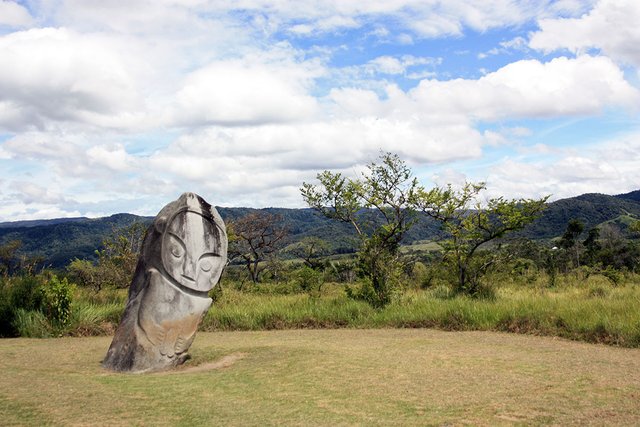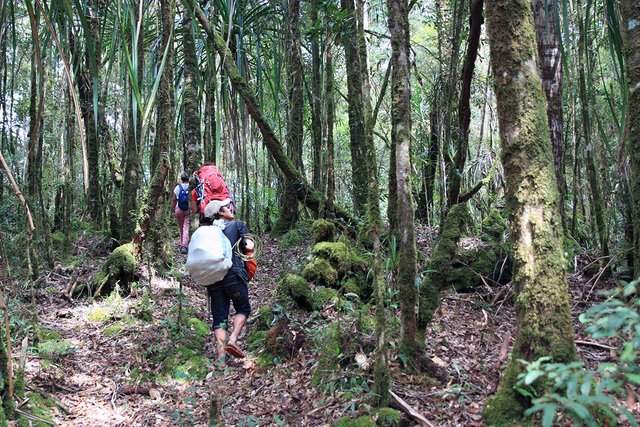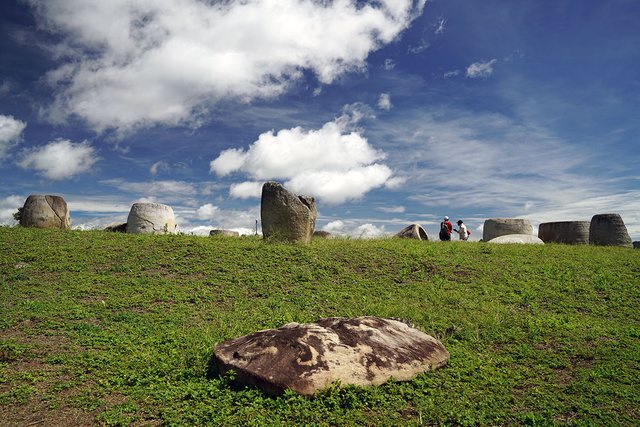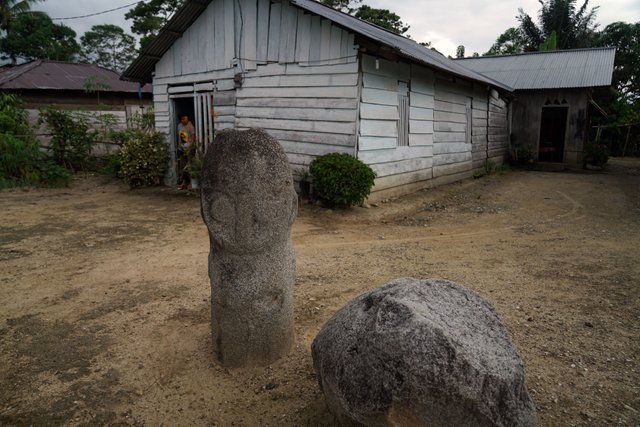
It’s not easy for me to find the right phrase that describes our journey across the two valleys through montana forest in Patoa Mountain, the name given by the locals for highly forested hills separating Bada Valley and Besoa Valley. The vegetation is so thick, that even the sun is having a hard time shining all the way down to the surface. On the other hand, different kind of moss creeps up all the way through half the height of tree trunks. While piles of dead leaves that haven’t fully decomposed cover our path, so soft that it makes us feels like walking through a giant sponge. Being in this forest, was like being in a high budget fantasy adventure movie. It makes us feels epic yet so small at the same time.
After spending one night in Patoa Mountain, the sun nearly disappears when we finally arrived at Basoa Valley. After two days in the forest, going to our lodging and cleaning up become our top priority. Tomorrow, we will continue our journey to look at megalith sites on Besoa Valley and Napu Valley.

With the amount of time we got left, visiting two valleys in one day requires us to rent a vehicle. Even then, we could only visit several iconic complexes. There’s no other way, we must go back to Palu to catch our flight home to Jakarta. I guess there’s no other choice then, considering how much sites that could be visited in both of this valley.
“It took at least one week to visits all of the sites”, explained our guide. Well, his word works as a bit of cure to our disappointment about how little time we got here.
Bada Valley and Besoa Valley pretty much have the same aura, life goes on without a hassle. Even their smell is the same. Before going to the sites, we went to visits someone house. It has a pretty large yard that is well organized, with perfectly trimmed grass and various nicely grown wild plant taken from the forest. This large house was nearly completed, designed with modern architecture.
Our host, a sturdy, big and tall man that introduced himself as “Tarzan”. We are sure that’s not his real name, but he insisted to be called so. Very well, Mr. Tarzan, it is.
Mr. Tarzan chooses to never use any kind of footwear anywhere he goes -- except the church. He’s a farmer that has a quite large influence on the local community, enjoys going in and out of the forest and always reminding other to not take anything from the forest without thinking about the effect. While his wife – that accompany us for a while before going to work – is a headmaster in one of Besoa public junior high school.
He is eager to engage in a conversation with us, and this lovely man excitement did not dwindle when we talked about historical heritage. He told us about his complain regarding Besoa kalambas (stone jars) replicate that was made to be put in Palu Museum and Taman Mini Indonesia Indah in Jakarta. He thought that it did not show the greatness of the real thing, even on the slightest. For that reasons he will never visit both of those places again, it only annoyed and make him angry. “Those uncultured people!” he added. His aura and passion suited him well to be a character on one of Borges’s short story.
This exciting conversation almost makes us forget our original purposes! We have not visited even a single site on Besoa Valley. Alright, Mr. Tarzan, it was fun, but we really need to go. But one thing leads to another, we did not take any picture together with Mr. Tarzan, which we just remembered after we left. Alright, next time we visit Besoa Valley, we will not forget. It’s a promise.

The first site we visited on the Besoa Valley is called Pokekea, to prove what Mr. Tarzan said about the greatness of its kalambas. Besides, the largest kalamba ever found in all of Lore Plateau are also located here. Mr. Tarzan is not wrong, these kalambas does look great! It’s smoother in style than those found at Bada Valley, and for some reason unknown to me, kalambas of various shaped appear to be located near to each other here. Tuatenas (a megalith that considered to function as a lid for the kalambas) could also be found here. In fine form as well.
From the quality, it’s obvious for me that whoever makes these megaliths are masters of geometry and understood the concept of aesthetics. A sudden realization that struck me and sends the shiver down my spine. These things of high quality were made by our ancestors, the people of the islands of Indonesian archipelago, thousands of years ago.
Yes, thousands of years ago! That was what the Pokekea Site Keeper, Sunardi, told us. Or at least that was what the researchers told to Sunardi. But, from Sunardi as well, we knew that a massif continuous research has never been done by Indonesian researchers on any of the sites, let alone the whole Lore Plateau. Researches have always been done sporadically with a maximum duration of one month which is being held at most once a year.

Next site on our list is Tadulako complex. On the local tongue, Tadulako means “warchief”, which suits well on these megalithic statues that appears as a seemingly authoritative man. Wavy engravement could be seen at the top side that depicts either a hair, a headband, or any other form of headdress. A lot of kalambas could also be found on this complex, but on different formation from those found on Pokekea. Kalambas on Tadulako seems to be put apart at distance from each other intentionally. After we got what we wanted on Tadulako, we continued our journey to the Napu Valley.

At Napu we find three medium size statues that are located on three different houses which are located not very far apart with each other. According to the locals, the three statues were not originally located at where they are now. They’ve been moved, for two reasons;
First, these statues could be customarily moved to the house of the chieftain or any other influential person. The second reason is to safeguard these statues from thievery, which often happens at Lore since the 1980s to early 1990s. No one knows how much kalambas and statues that have been stolen, thanks to the absence of a complete list of megalithic heritage at Lore. Some were “fortunate” enough to have only been “moved” by the thieves, as they were caught by the locals before completing their job. Though, nobody bothers to move it back to its original position.
We asked our driver to drive slowly on our journey back to Palu. No need to rush, we’ve still got enough time as our heart and soul refused to leave this majestic highland. Our brain is still processing all the memories and information we got. The memories are obviously still as clear as it could be, but not the information. Especially the information about its megalithic culture.
Everything is blurry. Folklore is the best information we could get from our guide and the locals. While the scientific information that we got from the site keepers was restricted on researchers’ assumptions.
The assumption on the megalith age (which was assumed to be created from 1500 BCE up to 500 CE), the assumption on the function of the kalambas as some sort of tomb, and the assumption that those statues are used for religious purposes. All of them stopped at “assumption”.
It feels like as if we’re walking through the middle of a dense forest enfolded in mist. We’re aware of the trees surrounding us but could not tell its species, its uses, and its purposes of existence. We just keep on walking, did not bother to unfold the mist or even just simply touch the trees.
If these megaliths were the products of a civilization, lets found out who made them? When does it start and why does it end? Those simple question hasn’t even been touched.
Based on “simple assumption” drawn by experts from various sources I’ve read later, these megalithic heritages were not made by the predecessor of modern Lore people which came around 5-6 centuries ago. Long after the civilization that creates them disappears. The reason for that “simple assumption” is that the modern Lore community did not have the skills to craft large stones like those of the megalith heritage. A controversial assumption that was opposed by the locals, though I agreed on it.
If that is the “simple assumption” then a new question arises, where does this megalithic civilization go? Is there any connection between these statues in Lore Plateau with moai-moai on Easter Island? Is there any connection between the kalambas of Lore with the kalambas of Plain of Jars in Laos? The list of what and why goes on waiting to be asked.
One thing became clear for me. These megaliths were created by an advance and prosper civilization. A structured and specialized community that exists not only to think about what they’re going to eat next. A community that put out their stories and knowledge through these large stones. Waiting to be learned through researches and studies. Researches that should be done continuously to uncover various layers of Lore civilization. It's not a question about how many things that we could get when we are able to knit each one of the results.
This is a historical legacy! We need to wake up! We couldn't naively hope to finish unfolding all its layers just by giving one month in a year of our time. Even that was on a rare occasion.
Now I understand Mr. Tarzan resentment and disappointment. I’m on your side, sir!
Posted from my blog with SteemPress : http://blog.spektakel.id/en/2018/11/06/lore-plateau-i-saw-i-came-i-am-captivated/
Congratulations, Your Post Has Been Added To The Steemit Worldmap!
Author link: http://steemitworldmap.com?author=gibic
Post link: http://steemitworldmap.com?post=loreplateauisawicameiamcaptivated-dmat7r4u6a
Want to have your post on the map too?
Downvoting a post can decrease pending rewards and make it less visible. Common reasons:
Submit
Looks like a very interesting site, especially the megalith. It seems like Mr. Tarzan was a unique person.
Downvoting a post can decrease pending rewards and make it less visible. Common reasons:
Submit
Yeah, it’s so epic. There are hundreds of megaliths in this Plateau. Mr. Tarzan is great! 😁
I published this story with heartbreak, because maybe you’ve heard it: Palu was hit by big earthquake and tsunami some weeks ago.
I heard that these megalith were fine tho.
Downvoting a post can decrease pending rewards and make it less visible. Common reasons:
Submit
Hiya, just swinging by to let you know that this post made the Honorable Mentions list in our daily Travel Digest, curated by @itchyfeetdonica. Please drop by to check out all the rest of today's great posts and consider upvoting the Travel Digest if you like what we're doing.
Downvoting a post can decrease pending rewards and make it less visible. Common reasons:
Submit
Hi @itchyfeetdonica. Thanks!
Small remarks: the name of the region is Lore Plateau, Sulawesi :)
Downvoting a post can decrease pending rewards and make it less visible. Common reasons:
Submit
The image of Pokekea with all the large kalambas is so fascinating. The kalambas look like gigantic pots ~ Were they functional and what were they made from @gibic? ♥︎♥︎⚖️♥︎♥︎
Downvoting a post can decrease pending rewards and make it less visible. Common reasons:
Submit
I arrived on your page with hopes that I could upvote a recent article as thanks for the post on Save the Cat! Lol, I'll keep looking ;) Or, perhaps you could leave a comment on one of my posts and I can upvote that...!
Downvoting a post can decrease pending rewards and make it less visible. Common reasons:
Submit
Oh, hi there @arbitrarykitten! I'm so glad to you find my old post. I thought it was already buried by other content. LOL. I also hope you'll find the Blake Snyder's as a good read about screenwriting. It's a fun read overall. :)
I'm heading to your blog now :D
Downvoting a post can decrease pending rewards and make it less visible. Common reasons:
Submit